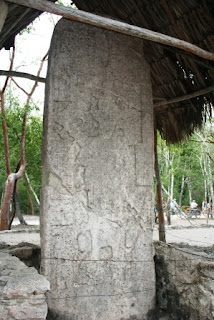We rambled about the Yucatan Peninsula visiting places familiar and new:
In ancient times, the city of Izamal was a center for the worship of the supreme Maya god, Itzamna, and the sun god, Kinich-Kakmo. A dozen pyramid temples were devoted to these and other gods. It's no wonder then why the Spanish built a huge Franciscan monastery there and why the Izamal is known as La Cuidad Amarilla (The Yellow City). Many of the city buildings are painted yellow..
 |
| Convento de San Antonio de Padua was started in 1533 using stones from a major Maya temple. It was finished in 1561. The huge atrium is said to be second in size only to the Vatican's. |
 |
| Coba has stelea, stone tablets, that depict female rulers from Tikal in Guatemala, giving rise to belief of an ancient alliance between the two powerful Mayan cities. |
 |
| Dee, on the left, decides not to climb 138-foot high Nohoch Mul, the second highest Mayan structure on the Yucatan Peninsula. |
 |
| One of two ball courts at Coba. |
Then it was on to Tullum on the coast. Oh my, what a spectacular site to build a Mayan city. We took the advice of our hotel manager and used the back entrance along the beach rather than the main entry which makes you walk through a Disneyland-style place and past rows of hawkers selling everything.
Peter and I wanted to swim on the magnificient Tullum beach so, on the advice of the hotel manager, we headed directly there when the site opened at 8 a.m. We had the beach to ourselves for about 10 minutes.
 |
| This beach belongs to the turtles and is off-limits to humans. |
 |
| Peter decending to the human's beach. |
 |
| Our beach. |
 |
| Well, not ours alone. |
 |
| Dee up there wathing us swim. |
 |
| Pete and Dee finally taking a look at the ruins. |
 |
| Not too shabby of a location to build your city. |
 |
| A Mayan summer cottage by the beach? |







































